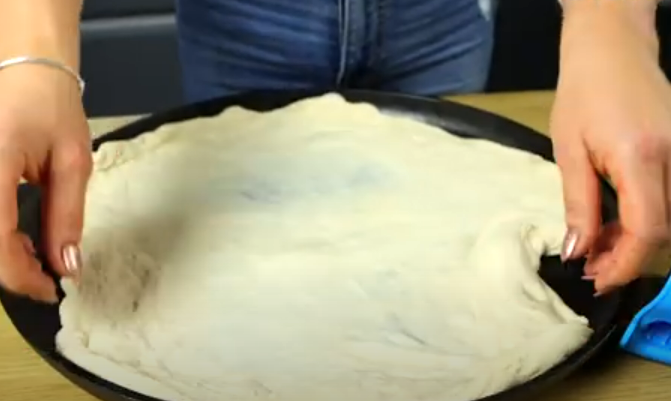Master Cast Iron Pizza Pan, preheat the oven, assemble your pizza, and bake until done. A cast-iron pizza pan is a versatile kitchen tool that allows you to create delicious homemade pizzas with a perfectly crispy crust.
Whether you are a seasoned cook or a beginner, using a cast iron pizza pan is straightforward and guarantees fantastic results. By following a few simple steps, you can enjoy a restaurant-quality pizza right in your own home. In this guide, we will walk you through the process of using a cast-iron pizza pan to create mouth-watering pizzas that will impress your friends and family.
Get ready to elevate your pizza-making game with the help of this essential kitchen tool.
Choosing The Right Cast Iron Pizza Pan
When it comes to choosing the right cast iron pizza pan, there are a few key factors that you should consider to ensure a successful pizza-making experience.
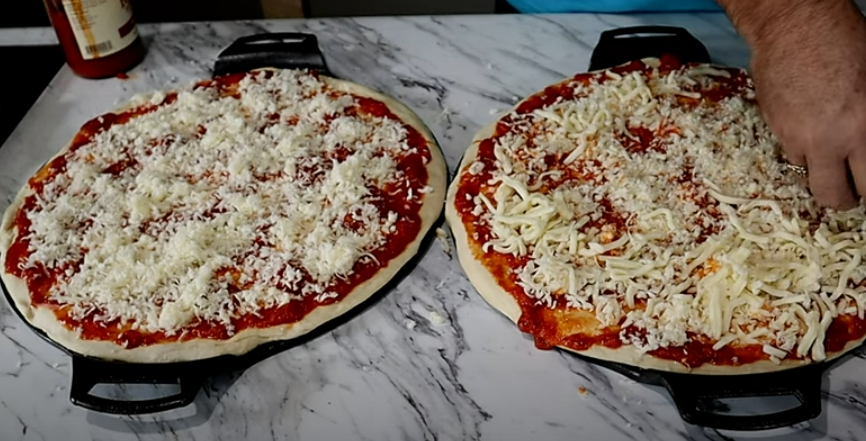
The Source: How to Grill Perfect Pizza with a Pizza Pan
Preparing Your Cast Iron Pizza Pan
If you want to achieve crispy and perfectly cooked pizzas at home, the Master Cast Iron Pizza Pan is a valuable addition to your kitchen arsenal. However, before you start creating culinary masterpieces, it’s essential to properly prepare your cast iron pizza pan. This involves two crucial steps: seasoning the pan and preheating it. Let’s take a closer look at how to accomplish these steps effectively.
1. Seasoning The Pan
Seasoning a cast iron pizza pan is a vital step that enhances its non-stick properties and prevents rust formation. Follow these simple steps to season your pan:
- Preheat your oven to 400°F (200°C).
- Thoroughly clean the pan with warm water and mild soap. Rinse it well and dry it completely with a soft cloth or paper towel.
- Apply a thin layer of vegetable oil or melted shortening all over the pan, including the handles and edges.
- Place the oiled side down on the middle rack of the preheated oven. Remember to position a baking sheet or aluminum foil on the bottom rack to drip drips.
- Bake the pan for about one hour, allowing the oil to polymerize and form a protective coating.
- After an hour, turn off the oven and let the pan cool down naturally inside the oven.
- Your cast iron pizza pan is now well-seasoned and ready to use!
2. Preheating The Pan
Properly preheating your cast iron pizza pan is crucial for achieving a crispy crust and evenly cooked toppings. Here’s how you can preheat your pan:
- Place your cast iron pizza pan in a cold oven.
- Set the oven temperature to the desired level (typically around 475°F to 500°F, or 245°C to 260°C) and allow the oven and pan to heat up simultaneously.
- Preheat the pan for at least 30 minutes to ensure proper heat distribution and retention.
- Once the oven reaches the desired temperature, your cast iron pizza pan is ready to use.
By following these steps to prepare your cast iron pizza pan, you’ll ensure it’s in optimal condition for making delicious homemade pizzas. Remember, a well-seasoned pan combined with proper preheating is key to achieving professional-quality results in the comfort of your kitchen.
Mastering The Pizza Dough
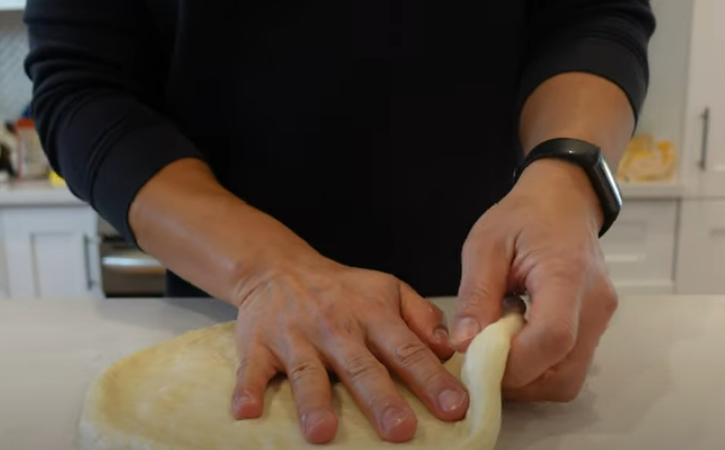
Creating the perfect pizza dough is essential to making a delicious homemade pizza. The right dough recipe and stretching techniques can make all the difference in achieving a crispy yet chewy crust. This section will discuss the key factors involved in mastering pizza dough, starting with selecting the right dough recipe.
Selecting The Right Dough Recipe
Choosing the right dough recipe is crucial for a successful pizza-making experience. Depending on your preference, you can opt for a classic Neapolitan-style dough, a thin and crispy crust, or a thick and fluffy deep-dish crust. Here are a few popular dough recipes to consider:
| Recipe | Characteristics |
|---|---|
| BASIC NEAPOLITAN DOUGH | Soft and chewy crust with a slight char |
| NY-STYLE THIN-CRUST | Thin and crispy crust with a foldable texture |
| DEEP-DISH CRUST | Thick and fluffy crust with a buttery flavor |
Consider your taste preferences and the type of pizza you want to create before choosing your dough recipe. Once you have selected the recipe, follow it precisely to ensure the desired texture and flavor.
Tips For Stretching The Dough
Stretching the dough can be a challenging task, especially for beginners. However, with a few tips and techniques, you can easily achieve the perfect crispy yet chewy crust. Here are some tips to help you:
- Allow the dough to rest at room temperature for at least 30 minutes before stretching to relax the gluten.
- Sprinkle flour on the working surface and your hands to prevent the dough from sticking.
- Start stretching from the center and work your way towards the edges, using your fingertips to gently push the dough outward.
- Avoid using a rolling pin, as it can compress the dough and result in a dense crust.
- Rotate the dough while stretching to ensure an even thickness.
- If the dough resists stretching, let it rest for a few minutes and then continue stretching.
By following these simple tips, you can easily stretch the dough without tearing it and create a beautiful crust.
Perfecting The Pizza Sauce
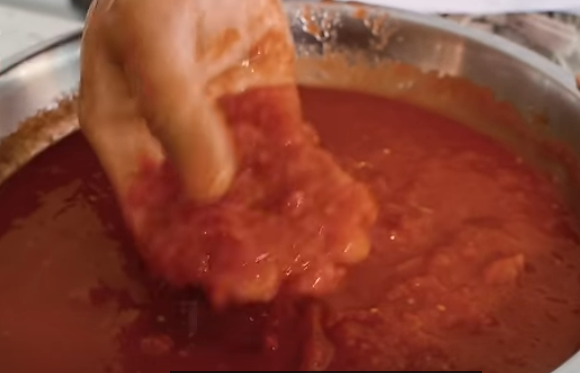
Perfecting the Pizza Sauce can make all the difference when using a cast iron pizza pan to create a delicious homemade pizza. The sauce is a crucial element that can elevate the flavors and bring everything together.
Homemade Vs. store-bought
Restoring your pizza sauce gives you control over the ingredients and allows for customization. Store-bought options may be convenient but can lack the freshness and flavor of homemade.
The Source: What is Handmade Pan Style Pizza Domino’s
Seasoning And Flavoring
Seasoning the sauce with herbs like oregano and basil can add depth of flavor. Garlic and onion can enhance the taste. Balancing sweetness with acidity is key for a well-rounded sauce.
Toppings And Cheese
Discover how to elevate your homemade pizza with delicious toppings and perfectly melted cheese using a cast iron pizza pan. -achieve a crispy crust and gooey cheese by preheating the pan, adding your favorite toppings, then bar toppings, and golden brown.
Unleash your creativity and indulge in a mouthwatering pizza experience at home.
Choosing The Best Ingredients
When it comes to making a delectable pizza at home using a cast iron pizza pan, selecting the right toppings and cheese is key. By choosing the best ingredients, you can elevate the flavor profile of your pizza and create a memorable dining experience. Here’s what you need to keep in mind when selecting your toppings and cheese:
Bold Flavors
- Opt for ingredients that bring bold, vibrant flavors to your pizza.
- Consider adding ingredients such as tangy sundried tomatoes or aromatic fresh basil for a burst of taste.
- Don’t be afraid to experiment with unique, spicy chorizo and sweet pineapple.
Quality Counts
Investing in high-quality toppings and cheese will ensure your pizza tastes amazing. Choose fresh vegetables, premium meats, and artisanal cheeses for the best results.
Texture Balance
Variety in texture is essential for a satisfying eating experience. Pair ingredients that offer a contrast in textures, such as crisp bell peppers with creamy mozzarella or crunchy bacon with velvety goat cheese.
Layering For Optimal Flavor
Once you have gathered your toppings and cheese, it’s time to layer them onto your pizza for optimal flavor distribution. Proper layering allows each ingredient to shine while working together harmoniously. Here’s how to layer your toppings and cheese:
Sauce First
Begin by spreading a thin layer of your favorite pizza sauce on the dough. If you prefer a bolder flavor, you can also brush olive oil infused with garlic and herbs onto the dough.
Even Distribution
For an evenly flavored pizza, make sure to distribute your ingredients evenly across the surface. This will ensure that each bite is bursting with flavor.
Cheese is Key
Place your cheese on top of the sauce or oil-infused dough. The cheese melts beautifully in the heat of the cast iron pan, creating a gooey, delicious layer that binds all the flavors together.
Finishing Touches
Lastly, sprinkle any additional seasonings, such as dried oregano or red pepper flakes, over the top to add an extra layer of flavor.
With these tips in mind, you can create mouthwatering pizzas using your cast iron pizza pan. Remember to have fun and don’t be afraid to get creative with your toppings and cheese selections. Happy pizza-making!
Baking The Pizza
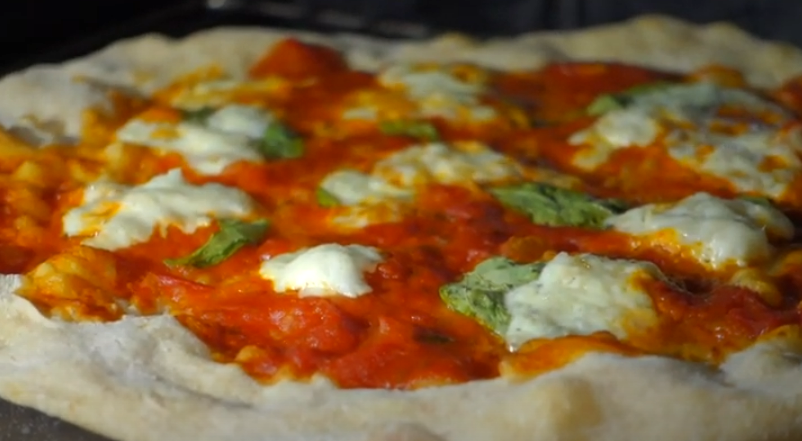
In this section, we will explore the key steps to achieving a perfectly baked pizza using a cast-iron pizza pan.
Techniques For Even Cooking
- Preheat the Master Cast Iron Pizza Pan in the oven before placing the pizza on it.
- Rotate the pizza halfway through the cooking process to ensure even heat distribution.
- Consider using a pizza stone underneath the pan for consistent heat transfer.
Checking For Doneness
- Check the pizza crust’s color, ensuring it is golden brown all around.
- Insert a toothpick in the center of the pizza to check for any uncooked dough.
- Tap the crust lightly to listen for a hollow sound, indicating a fully cooked pizza.
Caring For Your Cast Iron Pizza Pan
Proper care of your cast iron Pi-za pan is essential to ensuring its longevity and performance. By following these simple steps for cleaning, maintaining, and storing the pan correctly, you can enjoy delicious homemade pizzas for years to come.
Cleaning And Maintenance
When cleaning your cast iron pizza pan, avoid using soap as it can damage the seasoned surface.
Instead, use hot water and a stiff brush to scrub off any food residue.
After washing, thoroughly dry the pan to prevent rusting.
To maintain the seasoning, apply a thin layer of oil after each use.
Storing The Pan
Store your cast iron pizza pan in a dry place to prevent rust.
Avoid stacking other heavy items on top of the pan, as this can damage the seasoning.
Consider hanging the pan or placing a paper towel between pans if stacking is necessary.
Periodically check the pan for any signs of rust and reseason as needed.
Experimenting With Different Recipes
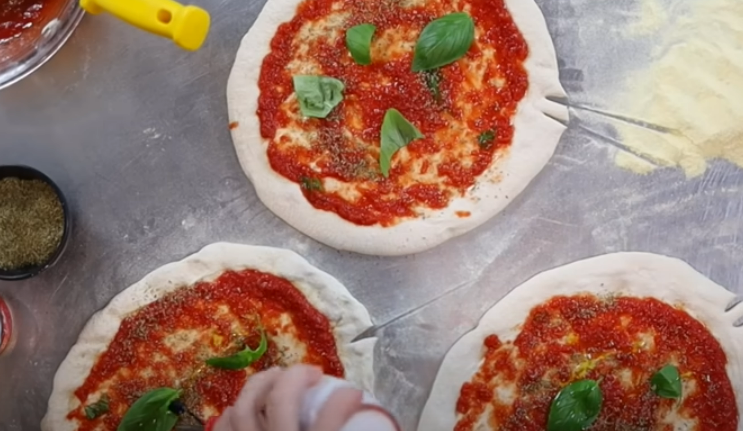
Experimenting with different recipes is a fun and exciting way to make the most out of your Master Cast Iron Pizza Pan. Whether you’re a seasoned chef or a beginner in the kitchen, trying out new and unique flavor combinations can elevate your homemade pizza experience. Additionally, adapting to dietary restrictions opens up a world of possibilities for those with specific dietary needs. In this blog post, we will explore how to unleash your creativity with the cast iron pizza pan by experimenting with different recipes.
Exploring Unique Flavor Combinations:
One of the joys of using a cast iron pizza pan is the ability to explore unique flavor combinations. With this versatile cooking tool, you can go beyond basic cheese and tomato sauces and experiment with an array of exciting toppings and sauces.
Consider adding bold and unexpected flavors to your pizza, such as:
- Spicy pepperoni paired with sweet pineapple chunks for that perfect balance of heat and sweetness.
- Savory bacon, creamy goat cheese, and tart cranberries create a thoughtful blend of flavors on your taste buds.
- Fresh arugula, earthy mushrooms, and truffle oil give your pizza a gourmet twist that will impress any food enthusiast.
Don’t be afraid to mix and match ingredients that you wouldn’t typically think go together. Remember, the Master Cast Iron Pizza Pan allows for even heating, enhancing the flavors and textures of your toppings.
Adapting To Dietary Restrictions:
The cast iron pizza pan is a perfect option for those with dietary restrictions, as it gives you full control over the ingredients used. Whether you’re following a gluten-free, vegetarian, or vegan diet, the Master Cast Iron Pizza Pan can cater to your needs.
If you’re on a gluten-free diet, experiment with alternative flour like almond flour or chickpea flour for the pizza dough. These flours provide a unique texture and a nutty flavor to your crust.
For vegetarians, the cast iron pizza pan is an excellent canvas for exploring a variety of vegetable toppings. Consider adding roasted peppers, caramelized onions, or marinated artichokes to bring out the flavors of the veggies.
Vegans can enjoy delicious plant-based pizza options by substituting traditional cheese with dairy-free alternatives like cashew cheese or vegan mozzarella. Load up your pizza with vibrant and colorful vegetables like bell peppers, tomatoes, and spinach to create a visually appealing and flavorful dish.
By making small adaptations to your favorite recipes, the cast iron pizza pan allows you to enjoy delicious homemade pizza that caters to your dietary needs.
Frequently Asked Questions For How To Use A Cast Iron Pizza Pan
How Do You Cook A Cast Iron Pizza Pan?
To cook a cast iron pizza pan, preheat it in the oven to 500°F for 30 minutes. Place the pizza in the pan and bake for 12–15 minutes. Rotate the pan halfway through for even cooking. Allow the pizza to cool for a few minutes before slicing and serving.
How Do You Keep Pizza From Sticking To A Cast Iron Skillet?
Preheat the skillet, add oil, let the pizza dough rest, spread the dough evenly, and cook on low heat.
Do You Have To Preheat Cast Iron Pan For Pizza?
Yes, preheating a cast iron pan is essential for making pizza. It helps to evenly distribute heat, ensuring a crispy crust and thorough cooking. Preheat the pan for about 15 minutes in the oven at a high temperature before placing the pizza dough.
Do You Oil A Cast Iron Pizza Pan?
No, you do not need to oil a cast iron pizza pan. Cast iron pans are naturally non-stick when properly seasoned, so oiling is not necessary.
How Do You Season A Cast Iron Pizza Pan?
To season a cast iron pizza pan, preheat your oven to 425°F, apply a thin layer of vegetable oil, and bake it for one hour.
Conclusion
Elevate your pizza game by mastering the art of using a cast iron pizza pan. With its versatility and durability, this kitchen essential is a must-have for any pizza lover. Experiment with different recipes and enjoy delicious homemade pizza like never before.
Transform your cooking experience with a cast iron pizza pan today.

